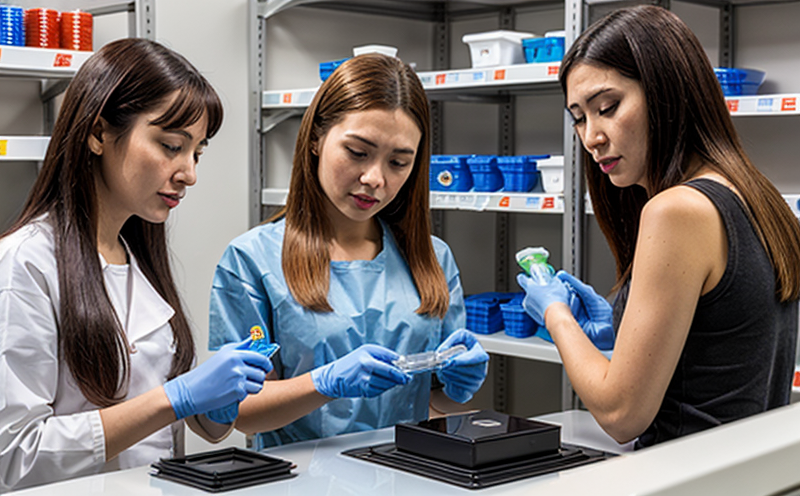UNE EN 717 Formaldehyde Emission Testing of Consumer Plastic Laminates
The UNE EN 717 standard is a crucial regulatory requirement for formaldehyde emission testing in consumer plastic laminates. This test ensures that products comply with safety standards, protecting users from harmful levels of formaldehyde, which can be released by certain adhesives and resins used in the production of plastics.
Formaldehyde is classified as a carcinogen under strict international regulations such as REACH (EU Regulation 1907/2006) and California's Proposition 65. Ensuring compliance with UNE EN 717 is not only a legal requirement but also enhances the reputation of your product in the market.
The testing process involves placing samples of plastic laminates within a climate-controlled cabinet where they are exposed to controlled conditions that mimic real-world usage environments. The formaldehyde content released by the sample over time is then quantified using precise analytical techniques. This process helps identify any potential health risks and ensures product safety.
Sample preparation for UNE EN 717 involves selecting representative specimens of plastic laminates, which are cut to standard dimensions as specified in the protocol. The integrity of the samples must be maintained throughout the testing period to ensure accurate results. This includes avoiding contamination with external sources of formaldehyde and ensuring consistent environmental conditions.
The test setup typically comprises a climate-controlled chamber designed to maintain specific temperature and humidity levels, along with precise monitoring equipment capable of measuring minute amounts of released formaldehyde. The duration of exposure can vary depending on the type of plastic laminate being tested but is standardized within the protocol to ensure consistency across tests.
After the specified testing period, samples are removed from the chamber and analyzed using gas chromatography or other analytical methods approved by relevant standards bodies. These methods provide quantitative data on formaldehyde content, allowing for comparison against set limits outlined in UNE EN 717.
The results of this test play a critical role in determining whether consumer plastic laminates meet safety criteria, thereby influencing decisions made at various stages from R&D to manufacturing and distribution. By adhering to these rigorous standards, manufacturers can assure themselves and their customers about the safety and quality of products they bring to market.
Understanding the nuances of UNE EN 717 helps stakeholders appreciate its importance in ensuring product safety while meeting regulatory demands. For those involved in quality management or R&D, familiarity with this standard is essential for effective compliance strategies that safeguard both consumer health and business operations.
Why It Matters
The significance of UNE EN 717 cannot be overstated when it comes to protecting public health and ensuring product safety. Formaldehyde, known as a potential carcinogen according to various international standards including REACH and California's Proposition 65, poses risks if present in high concentrations. Therefore, testing for formaldehyde emissions is vital.
Compliance with UNE EN 717 not only mitigates these health hazards but also enhances brand reputation by demonstrating a commitment to safety and quality assurance practices. Consumers increasingly value transparency regarding the materials used in products they purchase; meeting regulatory standards can significantly boost consumer trust.
From an operational perspective, ensuring compliance saves time and resources that would otherwise be spent on corrective actions or recalls due to non-compliance issues. Moreover, it fosters better relationships with regulatory bodies and potential customers who prioritize safety.
The importance of UNE EN 717 extends beyond individual products; it contributes to broader industry standards and practices. By adhering to these guidelines, manufacturers set a precedent for safer manufacturing processes, leading to improved overall product quality across sectors.
Benefits
The benefits of meeting UNE EN 717 requirements extend far beyond mere compliance; they offer substantial advantages that enhance both business operations and customer satisfaction. Firstly, it ensures the safety of end-users by reducing exposure to potentially harmful chemicals like formaldehyde.
Achieving certification through rigorous testing aligns your products with international standards, making them more competitive in global markets where stringent regulations are enforced. This can open up new opportunities for international trade and expansion into regions that prioritize health and safety.
For internal quality assurance teams within organizations, compliance fosters a culture of continuous improvement by encouraging ongoing evaluation and refinement of manufacturing processes. It also reduces risks associated with non-compliance penalties or product recalls.
Achieving certification through UNE EN 717 can lead to enhanced brand reputation among consumers who increasingly favor brands that prioritize health and safety. Positive reviews and testimonials from satisfied customers further reinforce this positive image, contributing to increased sales and market share growth.
International Acceptance and Recognition
The UNE EN 717 standard enjoys widespread recognition across Europe and beyond due to its stringent requirements for formaldehyde emission testing in consumer plastic laminates. This international acceptance stems from the harmonization of various national standards into a single, comprehensive framework aimed at ensuring product safety.
European Union countries have fully embraced UNE EN 717 as part of their regulatory landscape, integrating it into broader directives like REACH that govern chemical substances used in manufacturing processes. This harmonization simplifies compliance for businesses operating within the EU while maintaining high standards across borders.
Beyond Europe, many other nations including those adhering to ISO or ASTM standards also recognize UNE EN 717’s stringent criteria for formaldehyde emissions testing. Its adoption by international organizations such as Oeko-Tex further underscores its credibility and effectiveness in safeguarding consumer health.
The global acceptance of UNE EN 717 highlights the importance placed on rigorous quality control measures that reduce risks associated with harmful chemical compounds like formaldehyde. By aligning with these standards, manufacturers demonstrate their commitment to producing safe products suitable for diverse markets worldwide.





